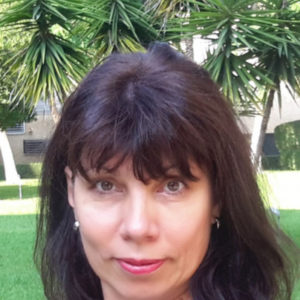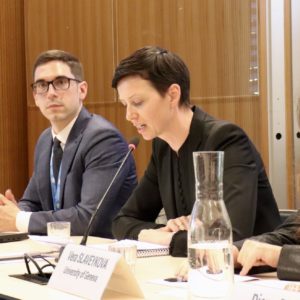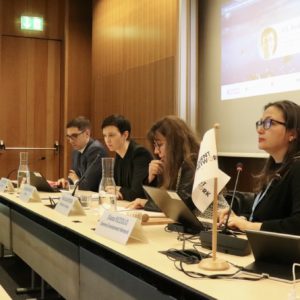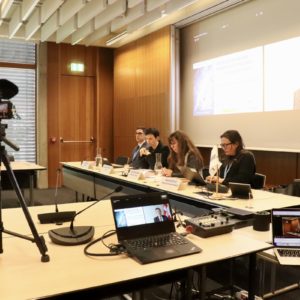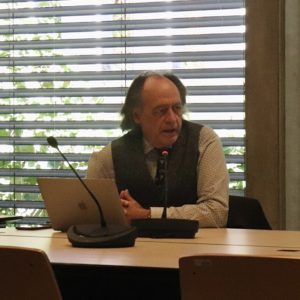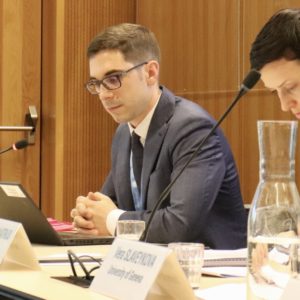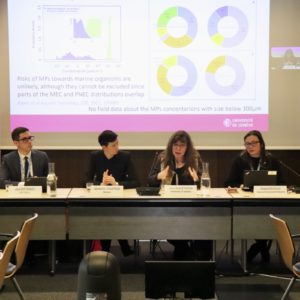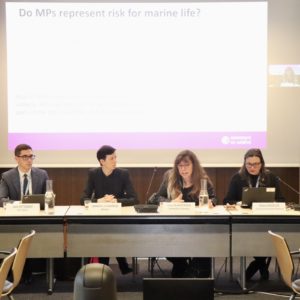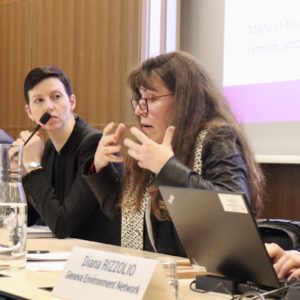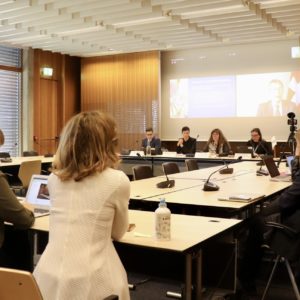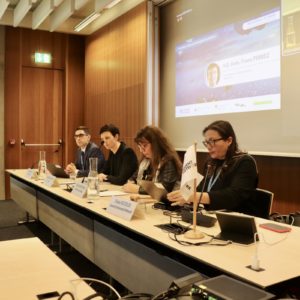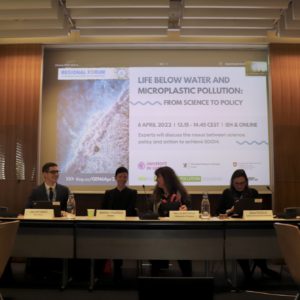Event Conference
Life Below Water and Microplastic Pollution: From Science to Policy | RFSD2022 & Geneva Beat Plastic Pollution Dialogues
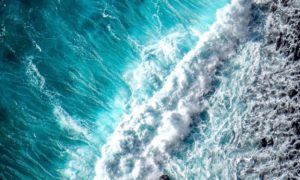
06 Apr 2022
13:15–14:45
Venue: International Environment House II & Online | Webex
Organization: University of Geneva, Switzerland, Geneva Environment Network
This side event to the Regional Forum on Sustainable Development is organized by the University of Geneva, the Geneva Environment Network, Norway and Switzerland, within the framework of the Geneva Beat Plastic Pollution Dialogues. The aim of this multistakeholder and evidence based policy focused event is to provide an overview of the current global state of science and policy of marine pollution by microplastics and possible impacts on life below water and to discuss the nexus of science, policy and action to achieve target 14.1.

About the Geneva Beat Plastic Pollution Dialogues
The world is facing a plastic crisis, the status quo is not an option. Plastic pollution is a serious issue of global concern which requires an urgent and international response involving all relevant actors at different levels. Many initiatives, projects and governance responses and options have been developed to tackle this major environmental problem, but we are still unable to cope with the amount of plastic we generate. In addition, there is a lack of coordination which can better lead to a more effective and efficient response.
Various actors in Geneva are engaged in rethinking the way we manufacture, use, trade and manage plastics. The Geneva Beat Plastic Pollution Dialogues aim at outreaching and creating synergies among these actors, highlighting efforts made by intergovernmental organizations, governments, businesses, the scientific community, civil society and individuals in the hope of informing and creating synergies and coordinated actions. The dialogues highlight what the different stakeholders in Geneva and beyond have achieved at all levels, present the latest research and governance options.
Following the landmark resolution to end plastic pollution adopted at the fifth UN Environment Assembly (UNEA-5), the third series of the Geneva Beat Plastic Pollution Dialogues will encourage increased engagement of the Geneva community with future negotiations on the matter. The resolution requests the establishment of an international negotiating committee to develop an international legally binding instrument on plastic pollution, including in the marine environment, by the end of 2024. This instrument could include both binding and voluntary approaches, based on a comprehensive approach that addresses the full lifecycle of plastic.
About the Regional Forum on Sustainable Development
The Regional Forum on Sustainable Development was established by the Economic Commission for Europe at its sixty-seventh session in April 2017, with the aim to create “a regional mechanism to follow-up and review the implementation of the 2030 Agenda for Sustainable Development” (E/ECE/1480, Decision B (67)).
At the 2022 Regional Forum the following Sustainable Development Goals (SDGs) are being reviewed:
- SDG 4 | quality education and lifelong learning
- SDG 5 | gender equality and empowerment of women and girls
- SDG 14 | life below water: oceans, seas and marine resources
- SDG 15 | life on land: terrestrial ecosystems, forests, desertification, land degradation, biodiversity
- SDG 17 | partnerships for the goals
About this Side Event
Preventing and significantly reducing marine pollution including marine debris is central for protecting the marine life and attaining the objectives of sustainable development and Agenda 2030.
Plastics production and use of plastic materials grows exponentially. Consequently, plastic pollution leakage into aquatic ecosystems has grown sharply in recent years and is projected to more than double by 2030, according to the UN Environment Programme 2021 assessment, with important consequences for human health, the global economy, biodiversity and climate.
This side event focuses on microplastics, a tiny plastic material with a size below 5 mm. Microplastics can be formed following the fragmentation of the plastic waste, washed out from synthetic clothes, car tyres or other products. They are widespread in the environment and can be found everywhere from the deep ocean to the most remote areas of our planet. The estimations show that up to 51 trillion microplastic fragments can be found on the surface of the ocean. They are environmentally persistent, transported over long distances, bioaccumulated in biota and have a potential to affect the life below water. Tackling such pollutants needs global actions.
As agreed at the last session of the United Nations Environment Assembly, an intergovernmental negotiating committee should be convened to develop an international legally binding instrument on plastic pollution, including in the marine environment, and should commence its work in the second half of 2022, with the ambition of completing its work by the end of 2024. An ad-hoc open-ended working group will convene during the first half of 2022 to prepare for the work of the intergovernmental negotiating committee.
What are the up-to-date scientific advancements concerning the possible effects and risks by microplastics to the aquatic life and biodiversity? What are the major sources and their relative contribution to the global microplastics budget? What are the scientific needs of policy and governance? How can this knowledge support global policy and governance, including the UN Ocean Conference, a new instrument on plastic pollution and achieving SDG14? These are some questions that were addressed to provide a scientific perspective of the plastics crisis with emphasis on microplastics feeding the ongoing discussions on a global policy framework on plastics.
Speakers

Jannicke GRAATRUD
Minister, Deputy Permanent Representative of Norway to the United Nations and other International Organizations in Geneva
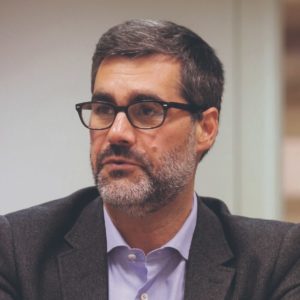
Nuno LACASTA
President, Portuguese Environment Agency
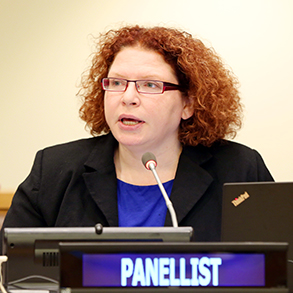
Heidi SAVELLI-SODERBERG
Programme Management Officer, Global Programme of Action for the Protection of the Marine Environment from Land-based Activities, UNEP

Jost DITTKRIST
Programme Officer, Secretariat of the Basel, Rotterdam and Stockholm Conventions
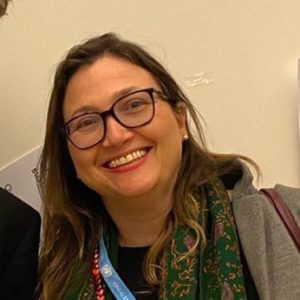
Diana RIZZOLIO
Coordinator, Geneva Environment Network | Moderator
Summary
Opening Remarks | Diana Rizzolio, Geneva Environment Network
Today’s event marks the launch of the third series of the Geneva Beat Plastic Pollution Dialogues, which kept the international community in Geneva and beyond engaged on this topic since the end of 2020, making links with the United Nations Environment Assembly and other international processes. The aim of this multistakeholder and evidence-based policy-focused event is to provide an overview of the current global state of science and policy on marine pollution caused by microplastics and possible impacts on life below water. Additionally, the event aims to discuss the nexus between science, policy and action to achieve SGD 14, which will be under review at the High-level Political Forum on Sustainable Development (HLPF) in New York later this year.
Preventing and significantly reducing marine pollution, including marine debris, is central to protecting marine life and attaining the objectives of Agenda 2030 for Sustainable Development. Plastics production and use of plastic materials are growing exponentially. Consequently, plastic pollution leakage into aquatic ecosystems has grown sharply in recent years and is projected to more than double by 2030. This will have important consequences for human health, the global economy, biodiversity, and the climate.
This side event focus on microplastics, tiny plastic particles with a size below 5 mm. Microplastics can originate from the fragmentation of the plastic waste, for instance, washed out from synthetic clothes, car tyres or other products. They are widespread in the environment and can be found everywhere from the deep ocean to the most remote areas of our planet. Estimations show that up to 51 trillion microplastic fragments are present on the surface of the ocean. They are environmentally persistent, transported over long distances, bioaccumulated in biota and can affect the life below water.
Notably, microplastic pollution appeared in media headlines in the past few weeks reporting it is snowing microplastic in the ocean, and that microplastics have been found in human blood for the first time. As we relaunch the Dialogues, this topic seems timely. Tackling such pollutants needs global action. As agreed at the last session of the UNEA, an Intergovernmental Negotiating Committee (INC) should be convened to develop an international legally binding instrument on plastic pollution, including in the marine environment, and should commence its work in the second half of 2022, with the ambition of completing its work by the end of 2024. An ad-hoc open-ended working group will convene from 30 May to 1 June in Dakar, Senegal, to prepare for the work of the INC.
Opening Remarks | H. E. Amb. Franz Perrez, Swiss Ambassador for the Environment
The Regional Forum on Sustainable Development of the UNECE Region is a great opportunity to contribute substantively to the High-level Political Forum on Sustainable Development (HLPF) through an exchange of knowledge, good practices and solutions to support the implementation of Agenda 2030. This year, SDG14 Life Below Water is under review and this event will also make useful contribution in that regard. Microplastics are an important issue to reach Target 14.1. A month ago, at UNEA-5.2, a highly important decision was taken in regard. The international community agreed to launch negotiations on an international legally binding instrument on plastic pollution, including also the marine environment. This global treaty will certainly make a significant contribution to the implementations of the SDGs, in particular SDG14.
With regards to today’s discussion, some key points of the resolution need to be mentioned:
- The resolution recognizes that we need to address plastic solution in all the compartment of the environment. Focusing on marine pollution alone is not sufficient as most plastic entering the ocean are from land-based sources.
- The mandate speaks to the need to address the full lifecycle of plastics. To prevent and reduce plastic pollution, we need to adopt a comprehensive approach that not only focuses on downstream measures, such as waste management and marine pollution, but also acts upstreams. We need to find ways to reduce the amount of plastic entering the markets and to build a safe and sustainable circular economy of plastics, where the most problematic plastics are phased out.
- The resolution explicitly mentions that microplastics are part of plastic pollution. This consensus will allow policymakers to consider the full spectrum on plastics. This also proof that plastic pollution is a concern for all countries, as microplastics are found everywhere, including in landlocked county like Switzerland.
- Actions must be guided by the best available science. In relation to the lastest findings of microplastic in human blood, it is clear that the implications on human health require further assessment.
More analyses are also needed to identify ways and means to address the issues of microplastics leakage. Strengthening the science-policy nexus is extremely important, in particular with regards to microplastics. Microplastics will certainly be a horizontal issue during the plastic treaty negotiations as it is an issue of concern in all the stages of the plastics lifecycle. The Nordic Council will dedicate its next report to microplastics (to be published at the end of the year).
In conclusion, it is important to note the synergies and the competences that Geneva can offer on this topic. So far, initiatives and actions has taken place at an impressive rate and their continuation will support the process in Geneva. We are witnessing an engagement from academic institutions to support policy, building an awareness that their role is crucial already in the first phase of the treaty. The launch of the third series of the Geneva Beat Plastic Pollution Dialogues also plays a fundamental role in Geneva, adopting a multi-stakeholder approach to foster learning from different perspectives and to forge synergies. It is through these kinds of partnerships and collective work that we will build a strong coalition to address plastic pollution.
This year, there are several key milestones along the way to advance the work on plastics: the current Regional Forum or Sustainable Development, Stockholm+50, the BRS COP, the UN Ocean Conference and HLPF, just name a few. On top of these, the process of towards a new plastic treaty will start in May with the Open-Ended Working Group. Before the end of the year, we should see the first Intergovernmental Negotiating Committee (INC). These negotiations are of utmost important to successfully develop a framework that really will make a difference on the ground. Therefore, we’ll have to work hard together to bring to the law a robust treaty that is effective and efficient and that contains the measures needed to address plastic pollution throughout its lifecycle. That will be critical to help us to achieve SDG 14.1. Therefore, we must do everything possible to support these negotiations. We stand ready to our to do our part, notably through experience that we have in Geneva.
Scientific Perspective | Prof. Vera Slaveykova, University of Geneva
For a better understanding of Prof. Vera Slaveykova’s presentation on the latest science on microplastics, please consult her slides (available for download under the “Documents” section of the page).
Microplastics and plastic objects are everywhere. We cannot imagine life without plastics. In the past decades, there has been an exponential growing production and use of plastics objects and concomitantly an increase of plastic objects in the environment. This comprises waste, and microscopic objects, going towards nanoplastics. These are raising concerns about the environmental implications of plastic waste in general and in micro and nano plastics. We currently estimate there are five trillion microplastic pieces in the ocean. These objects come from various sources. First, from the so-called primary microplastics, found and intentionally produced in everyday products, for example, in toothpaste and creams. They have also a huge use in different kinds of industries. Then, microfibers contribute more than 35% to global microplastic pollution. These are released out when washing clothes, estimating around 1900 microfibers per item that are released.
Another important group of secondary microplastics is produced by the fragmentation of big plastic waste objects, through different processes, like UV light, ocean waves and aquatic systems and different biological processes. Secondary microplastic pollution highlight the close link between microplastic pollution and macroplastic waste. Indeed, rivers that are carrying plastic waste are contributing to more than 90 of the plastic inflows in the ocean.
These microplastics can be found in the deepest part of the ocean to the top and mountains, including Arctic ice and so on. They are globally distributed but it is important to identify hotspots with high microplastic concentrations. On this map, showing the distribution of the different sizes of microplastics, two kinds of hotspots are evidenced. The first kind being coastal areas and the second the ocean. It is therefore a certainty that microplastics are everywhere.
What is then the possible impact on human and planet life? Microplastic is taken up by marine biota in general, they are ingested by different organisms, such as zoo plant species like filter feeders. This is due to the similar sizes of microplastics and phytoplankton, Despite part of the microplastics will be excreted, animals are unable to expel it all from their bodies. Ingested microplastic can be transported through aquatic food webs and it can contaminate different tissues and organs once accumulated in the organisms. As an exemple, microplastics were found in the gut, in the liver, and the gills of fish. Accumulation is certain but it is necessary to understand the consequences, in terms of toxicity, of microplastics in aquatic organisms.
Are microplastics harmful for marine life? The literature reveals a plethora of possible effects for different organisms, from algae to molluscs. These can be categorized in two groups: the physical effects (including inhibition of food assimilation and/or decreased nutritional value of food, physical stress or damage) and the chemical effects (related to the additives, absorbed hydrophic contaminants or toxic metals, and pathogens forming biofilms on the particles). The chemical effects of microplastics are more worrying since they can act as platforms for chemical cocktails. Additionally, these present a threat as there are different additives that can be released under some conditions, like hydrophobic contaminants found in the aquatic environment, toxic metals and pathogens, which microplastics due to their small size and higher activity can absorb. There is a big uncertainty with the information that we have available. Microplastics have a complex pathological profile, but it is important to bear in mind that it is the doses that make the poison. It is a matter of concentration.
Another good example of microplastics’ chemical effects is the leaching of a lot of substances. On top of being toxic even for the organisms at the bottom of the food chain, we should keep in mind that plastic is made by using about 10,000 substances and these can have different roles. A very recent study has shown that maybe 2400 of these substances could be of concern.
We know plastics are in the environment and that these can induce risks, but again, this question is about concentration. There currently are no tools to conduct a direct measurement, but with a probabilistic risk assessment of the results for the marine system could be gathered. These allow comparison of the concentration and their distribution measured in the marine environment with the concentration of the plastic. This shows that there is no effect induced to biota as these distributions are very well distinct. That means that under the current situation, we can say that the risk is unlikely, but in the hotspots, there is this overlap in the distribution, risk is not to be excluded. There is a big uncertainty, and more work in this direction is needed because when we compare the sets of data available about the exposure and data set about toxicity results, there is a big difference in the materials found in the environment with respect to those tested for toxicity, and the same concerning the sizes and shapes. Another a big issue currently is that we do not have data about the microplastic concentrations with a size below 300 micros.
Are microplastics hazardous for human health? Recent studies have estimated that annually, by consuming different seafood, we can ingest about 55,000 particles. The different distributions show higher concentrations in countries depending on food habits and other factors. Thus, we are exposed to microplastic and this is just one of the exposure roads. We still do not have an answer to the question of how microplastics affect human health. They can be found in the excretion of both human babies and adults, and in blood as we recently discovered. As more studies on these are necessary, the key information to be understood for the moment is that microplastic can pass the biological barrier and can travel around the body.
The question of microplastic pollution is not just a problem for the ocean, but also a problem for the terrestrial ecosystem. An example is Lake Geneva, one of the first lakes in the world where the estimation of the number of microplastics was made. About 220,000 microparticles per km2 were found. It was also found that this material can be ingested by different biota, depending on the size of the particle. Making an eco-toxicity estimation with this species allows evaluation depending on the size, and the material’s toxicity. It is likely for it to be either toxic or harmful according to European Hazard Classification.
The scientific community has a role to play to support plastic policy and governance. To achieve SDG14 we must reduce plastic pollution. We cannot remove the microplastic from our ocean with currently existing technology. From an environmental chemistry and eco-toxicology perspective, the priority currently is to produce the best possible science to help reduce the existing uncertainty. With low uncertainty, it will then be possible to answer to whether microplastics pose any risk to the aquatic environment and to human health.
To do so, we must develop sampling and measuring methodologies that allow bigger precision and assessment up to the lowest possible sizes of this material. These can then be used for monitoring, and in the future for monitoring the future. Developing concepts and models that also can be used to assess the possible risk and impacts. The scientific community also has a responsibility to contribute to education and to raise awareness on plastic pollution, especially invisible plastic pollution from microplastic and nano plastics.
Panel Discussion
From Science to Policy | Heidi Savelli-Soderberg, Programme Officer, United Nations Environment Programme
The UNEA resolution opens the door to considerations of microplastics within the process of the Intergovernmental Negotiating Committee (INC). Product design is one of the issues that the resolution mentions as part of the provisions that the INC may consider. This speaks to the very relevant issue of intentionally added microplastics, for example in cosmetics. The INC may also consider health, both human and environment, as areas of work. Here again, micro- and nano-plastics are an important point to consider, also in the context of abrasion.
Going forward, the Ah-hoc open-ended working group (OWEG), which will take place from 30 May to 1 June 2022 in Dakar, Senegal, will discuss rules of procedures an organizational work, amongst other things. It will provide guidance to the first INC, which is anticipated to take place in the second half of 2022.
With regards to microplastics, UNEP published “From Pollution to Solution” in October 2021. The report highlights concerns regarding monitoring and assessment of microplastics. This is due to the variability in size, shape and degree of degradation of these particles, as well as considerable sampling biases for determining the volume of microplastics in different compartment, including in biota. Without significant improvement in quality assurance and control protocols for sampling and analytical techniques, it will remain difficult to demonstrate the reliability and repeatability of published results.
Therefore, the report points out that the data collected is rather fragmented, and that there is a need to streamline methodologies, data flows and indicators. Additionally, we need to facilitate joint analysis, unified definitions and infrastructure for data sharing around microplastics, to allow us to consolidate and build the body of knowledge that policy-makers can benefit from.
The report further highlights future research priorities, including the establishment of monitoring frameworks and standard methodologies, but also with regard to the potential toxicology of microplastics and additives in different compartment, including in the environment, to be able to measure the effectiveness and impacts of different interventions and mitigation efforts.
Microplastics differs in size, range and types, which brings complexity to how we manage them. Different types would require different ways to address them. The report highlights the need for risks framework to assess the risks that different microplastics pose to ecosystems and biodiversity, as well as human health and society. In this area, UNEP is working with the Group of Experts on the Scientific Aspects of Marine Environmental Protection (GESAMP), which initiative discussions around microplastics and risks framework. We also need to consider the finance risk, which is part of the problem: could there be liability-related aspects around microplastics in the future? This is a question insurance companies may wish to consider.
Panel Discussion | From Science to Policy | Nuno Lacasta, President, Portuguese Environment Agency
The United Nations Ocean Conference will take place in Lisbon from 27 June to 1 July 2022. The preparatory process for the conference includes negotiations on the political declaration to be adopted by consensus. This declaration is concise, action-oriented, focused on solutions based on science and innovation to support the implementation of the SDG14. The co-facilitators, Grenada and Denmark presented a draft in February and this declaration is currently under creation at the UN in New York.
The issues that will emerge as part of the declaration include topics such as solutions or decisions based on science such as the climate-ocean nexus, the blue economy, the complete water cycle pollution from plastic waste and marine litter, and the negotiations on the international treaty. Additionally, initiatives related to the establishment of good management of main protected areas among other topics will be discussed.
The eight interactive dialogues will address topics that were decided at the preparatory meeting held in February 2020, and were based on a proposal presented by the UN Secretary-General in line with the SDG14. Liu Zhenmin UN Under-Secretary-General for Economic and Social Affairs was appointed as conference Secretary-General and has invited member states to submit comments for the concept papers for these interactive dialogues, which should be finalized by the end of April 2022. After a call from the Member States to express the interest of their governments’ high-level representatives to serve as Co-chairs, the selection process for such Co-chairs is now underway along with the selection of moderators. Each dialogue will have two co-chairs and one moderator and four Members of the Panel. It is important to have a diverse makeup for these panels composed of political representatives. officials and experts. Some of the topics that will be part of these dialogues include
- managing, protecting conserving and restoring marine and coastal ecosystems,
- minimizing and addressing ocean acidification,
- making fisheries sustainable,
- promoting and strengthening sustainable ocean-based economies – in particular for SIDs and LDCs,
- increasing scientific knowledge and developing research capacity,
- managing microplastics,
- and more.
The management of microplastics is very important in the dialogue on addressing marine pollution. There is now widespread consensus that the ocean cannot absorb the current amount of human waste and that the problem of marine litter is not a myth. To address this, everybody needs to be involved: both countries producing the vast amounts of plastics and those that happened to be the destination.
High-Level Segment
The UN Ocean Conference will also have a High-level Segment from 27 June as well as several preliminary sessions dedicated to statements by the heads of delegation, including heads of state and government. The conference will involve all stakeholders relevant to the implementation of SDG14, bringing together governments, inter-governmental organizations, international, financial institutions, civil society organizations, academia, the scientific community, the private sector, philanthropic organizations, and other actors. This very diverse makeup will allow profit from various inputs to move forward on how to protect the ocean. The priority of the conference is to achieve tangible results through the involvement of all these stakeholders and particularly the private, public, and financial sectors. And again to channel the coordination and cooperation between various international initiatives as well as youth in the area of the sea. This orchestrated work is evidenced by the UN Ocean Conference in 2017, the UN decade on Ocean Science for Sustainable Development (2021-2030), the Second World Ocean Assessment (WOA II), the Our Ocean Conference taking place in Palau this year, and One Ocean Summit, among others.
In this context, it is also important to stress that the UN Secretary-General sent invitation letters to the Conference to all heads of State and governments to encourage countries to participate in the highest political level. It is expected that the UN Ocean Conference will become a landmark event in terms of sustainable development. This will feed onto processes and high-level discussions both at the COP15 for the Convention on Biological Diversity, and COP27 on climate change. The Secretary-General also sent a letter to international donors and to the private sector, financial institutions, and other potential donors, encouraging voluntary contributions to a trust fund to support the participation of representatives of developing countries. The priority here has been given LDCs and SIDs.
Side- Events
In addition to the official program, there is a host of very diverse events being organized including a High-Level Symposium On Water, to address the water cycle, Sustainable Blue Economy Investment Forum, the UN Ocean Conference n Youth and Innovation, and more. Along with these side events, others are encouraged and the enrollment for such an event can already be accessed online until May 8.
Nairobi Group of Friends to Combat Marine Litter and Plastic Pollution
The Nairobi Group of Friends to Combat Marine Litter and Plastic Pollution is a voluntary, non-legally binding, inclusive and open-ended association of all interested members and states. It currently counts 39 Member States plus the delegation of the European Union, 22 NGOs and one IGO. Since the Group’s establishment, various Nairobi Dialogues Series were organized to address issues such as trade, plastic pollution and circularity of chemicals and health, legal aspects of the potential intergovernmental committee global circular economy for plastics with perspectives from the private sector and the just transition focusing on the informal sector whose important role is recognized in the resolution.
In the framework of the Nairobi Group of Friends, Portugal and Chile launched the informal group intending to drive ambitious, coherent and effective, global action against plastic pollution in the lead up to UNEA 5.2. This includes among other aims, galvanizing support for the development and consideration of an effective global governance framework to combat marine litter and plastic. Considering the adoption of the landmark resolution to end plastic pollution towards an international legally binding instrument by UNEA-5.2, the objectives of the Group have been revised to reflect the developments mentioned and in support of the process that is now starting. Therefore, the Group will continue the technical and policy dialogues series in Nairobi, and other relevant and formal activities in support of the work of the framework of the intergovernmental negotiating committee to continue creating capacities, improved knowledge-sharing.
Panel Discussion | From Science to Policy | Jost Dittkrist, Programme Officer, Secretariat of the Basel, Rotterdam and Stockholm Conventions
The Basel, Rotterdam and Stockholm Conventions (BRS MEAs), and in particular the Basel and Stockholm can and already are contributing to addressing microplastics.
A very good example of the science-policy interface is how the Basel Convention Plastic Waste Amendments, adopted in 2019, actually came to be. It was the mounting scientific evidence that, provided the impetus for governments to come together and adopt the amendments.

The Basel Plastic Waste Amendments matter for microplastics across three pillars.
- The amendments imply that all plastic waste, including mixtures of plastic waste generated by Parties to the Convention and which are to be moved to another Party, are subject to the prior informed consent procedure unless they are unlisted from hazardous types, destined for recycling in an environmentally sound manner, and almost free from contamination and other types of waste. So, the conditions are quite strict. This links to microplastics as if we have more control of transboundary movements, and less plastic waste being traded illegally, it also means we will have less plastic waste that is not managed in an environmentally sound manner and that is dumped. As a consequence, there will be less fragmentation of plastic waste into secondary microplastics. Despite the centrality of the Basel Convention on this matter, when it comes to trade and transboundary movements, the Stockholm Convention is extremely important. Microplastics carry hazardous chemicals and many of these are classified as Persistent Organic Pollutants (POPs) and listed under the Stockholm Convention. A very interesting recent case that underlines the science-policy interface relates to the 2021 Persistent Organic Pollutants Review Committee (POPRC) of the Stockholm Convention decision. It decided UV 3 to 8, which is also used as a high-volume additive in various plastic products satisfies all of the criteria noted in Annex D of the Stockholm Convention, including the potential for long-range environmental transport. Essentially, it was found that this chemical is being transported with marine debris long-range through the environment. In 2022, the POPRC decided that this chemical is therefore likely – as a result of its long-range environmental transport – to lead to significant adverse human health and/or environmental effects. To a lesser extent, the Rotterdam Convention is also very relevant. This applies to trade and trade in chemicals, to the informed consent procedure, as well as the information exchange mechanisms that apply to the listed chemicals. It can be a very helpful tool in addressing chemicals that end up in plastic products and eventually also in plastic waste.
- The specified categories and the plastic waste amendments are also subject to the Basel Convention’s provision on environmentally sound management. Here again, if we manage plastic waste that is not already primary microplastics in an environmentally sound manner, then the amount of microplastics that end up in the oceans can also be significantly reduced. Under the Basel convention, we have a lot of guidance and tools for this purpose as the Technical Guidelines on the Environmentally Some Management of Plastic Waste, are currently being updated. Also for this pillar, the Stockholm Convention is very relevant because there is also a lot of waste that is contaminated with POPs. In this sense, the Secretariat is currently implementing a project together with Universities, with the financial support of Norway, to map the global governance landscape of management of chemicals of concern used in plastic, and it will also outline options how a global plastic agreement could address such chemicals.
- The specified categories under the plastic waste amendments also pertain to the specific provisions on prevention and minimization. If we look at the waste hierarchy, it becomes apparent that the most preferable option for addressing any type of waste is always prevention and minimization. The waste hierarchy is among the guiding principles of the Basel Convention Strategic Framework for Implementation. Essentially, it says that if prevention minimization is not possible, the next best option is reuse, and then going further down the hierarchy there are recycling, recovery operations, including energy recovery, and then finally final disposal as the least preferred option. Microplastics, present very unique challenges as there are primary and secondary microplastics, microplastics being generated during processes like recycling operations in the textile sector. Because of this, the waste hierarchy is even more important. It provides the most efficient, and the most direct way of reducing, um, releases to the environment of whatever type of microplastics now. Concrete examples of prevention and minimization, we are currently implementing a pilot project in Ghana trying to use compostable packaging that is made from seaweed in order to replace water sachets, normally made from plastics and which pose a huge pollution issue in Ghana. Another example is the introduction of reusable bags. In relation to recycling, we have a project where we with our partners we collect and then recycle plastic fishing nets. Fishing nets, they often dumped in the ocean and at a certain point, they start fragmenting leading to microplastics by collecting and recycling less plastic will be dispersed in the ocean. Another example regards the replacement of microbeams from being used in cosmetics or toothpaste. As we move further down the hierarchy, let’s think, for example, about recycling. Projects are also in place to collaborate with the recycling sector to provide them training, because a lot can be done at a very low cost to minimize the releases of microplastics from recycling operations in particular and developing countries. Additionally, we are now planning a pilot in Sri Lanka, with the support of Norway, to work with the textile industry’s major source of microplastics.
The BRS MEAs Secetariat is also providing technical assistance and training to customs officers and authorities to allow them to control plastic trade and plastic waste trade efficiently.
In conclusion, we urgently need to address primary and secondary microplastics as well as the hazardous substances carried by them and keep in mind the waste hierarchy. We need instruments at three levels:
- Preventing microplastics from being generated in the first place.
- Ensuring the environmental sound management of plastic waste to avoid fragmentation.
- Controlling transboundary movements of plastic waste to avoid the releases of plastic leading to further degradation.
At the same time, we must address the chemical dimension such as by phasing out the use of certain hazardous chemicals. In different ways and in a complementary manner, all the BRS Conventions can make very important contributions to addressing microplastics across these dimensions.
Q&A Session
Q to Vera SLAVEYKOVA: One of the, the elements that have been discussed extensively during the UNECE Regional Forum and in the Forum of Mayors is data.
What kind of data is available at this point, and how far it can be contextualize in terms of refining desegregating existing data to be able to come up with sound policies?
Vera SLAVEYKOVA:
A lot of work was done in the last fifteen years, both on the assessment of the concentration of the microplastic in the environment, and also on the impact and effect of different biota.
Somehow the data available about the concentrations have some limitations, and the data that concern the impact are also they are not very with what is found in the environment. The reason for this is the lack of tools that allow us to measure these materials, especially materials with lower sizes. These types are fundamental to be measured as considered to be more reactive than bigger material, and consequently generating more significant interactions and effects. We must be considering the biochemical cycles at the global level concerning the flow of all this material in all the environmental compartments. We must emulate what is done for other different kinds of contaminants, covered either by Minamata or Stockholm Conventions and more. We are on a good path we must go further.
Q to Jost DITTKRIST: What evidence is there that these plastic alternatives are displacing plastics in the market, rather than just supplementing? What policies should we be putting in place to encourage that displacement?
Jost DITTKRIST: This is exactly the kind of question that we try to answer with the pilot project in Ghana. The introduction of the composable seaweed packaging will be accompanied
by several surveys that we will implement throughout the pilot both with the vendors that are going to use this packaging and the customers who will buy the products that are packaged in this way to find out if there is actually a take-up from both customers and vendors. We need both sides to be fully on board. What we have seen so far is that there is a small, but not a negligible competitive disadvantage for these compostable seaweed packaging, compared to traditional thin plastic used for example for water sachets. One of the most obvious ways this could be addressed is for example through a tax that would apply to plastic packaging. In fact, some countries have taken steps either, already implemented, or are taking steps toward such taxes on plastic products. By raising the prices of plastics products, the alternatives may become more competitive over time. This is our hope and indeed we hope to learn more about these things. There are a number of these alternatives that are deemed or labeled biodegradable but are only biodegradable under circumstances, such as above 60 degrees in industrial combustors, etcetera. So they often contaminate the waste stream and recycling becomes more difficult. We must be cautious around these kinds of alternatives and first have the scientific evidence before moving forward.
Q from Yves Lador, Earthjustice: Considering the resolution adopted at UNEA-5.2 supporting the establishment of a comprehensive and ambitious science policy panel on the sound management of chemicals and waste and preventing pollution. How will this dialogue between the very specific scientific bodies of the various Conventions and the more general expertise continue?
This is precisely the advantage of what we hope to see from these new instruments. How do you foresee the parallel articulation of the scientific bodies and the political bodies during this process of the negotiation?
Franz PERREZ
The Science-Policy Panel that will be established will not replace the very specific scientific institutions that are already present within the Conventions. These scientific bodies within the Convention have very specific mandates and will continue to do so.
The Science-Policy Panel that will be established will have other functions, firstly horizon scanning to help us detect early topics requiring policy development. In future, this panel could be certainly also supportive of the work we are doing now to negotiate the new legally binding instrument on plastics.
The panel will not be able to deliver its results within a short period of time. We will still need various UNEP-related bodies to continue looking at very specific questions that have to be solved in order to develop the LBI. In order to find out, what are the best tools to address the elements contained in the LBI, UNEP will probably have to undertake very specific studies to support the negotiations. This new science policy panel will not replace the need for the specific mandates of the scientific bodies of the Conventions, nor will need to be able to deliver the very specific inputs needed for ongoing negotiations on the plastic agreement without these. It will certainly be helpful in future to earlier detect new emerging issues.
Take Away Messages | Panel
Vera SLAVEYKOVA
The ocean is an essential component of the earth’s ecosystem, and it is life-supporting. Humans depend on the ocean for many of our needs. It is critical for the sustainable development of our planet. When we pollute oceans with plastics or any other substances, that means we make them ill. All of us, from the scientific, policy, government, citizens positions, need to put all the efforts together and find the best possible solution to treat the causes and not just the symptoms.
Heidi SAVELLI
The issue of microplastics is complex. We still do not have a good enough definition of what microplastics are. Are they solid or are they not solid? There could also be considerations defining what are essential uses of the intentionally added microplastics or primary ones, what is unnecessary, avoidable and problematic, and how the prior informed consent can operate in the context of intentionally added plastics.
Nuno LACASTA
First, we need informed and science-based policy-making. Secondly, we have now a public awareness window as it were that we must not waste going forward. The publics are really demanding from authorities that we address issues of plastic pollution, particularly microplastic. Hopefully, the Lisbon Ocean Conferences will provide another moment to come together and move forward on these matters.
JOST DITTKRIST
Science is clear that we need to address primary and secondary microplastics, as well as hazardous chemicals carried by them. In doing so, it is critical that we keep in mind the waste hierarchy. That means first that we need to tackle the issue at the source, reducing the use of primary microplastics and hazardous chemicals. Secondly, we must ensure that plastic waste is managed in an environmentally sound manner to reduce the releases of secondary microplastics and hazardous substances. Third, to promote the exchange of information and control of trade and chemicals, and transboundary movements of plastic waste. The BRS Conventions can provide important tools in that regard.
Franz PERREZ
Three takeaway messages. First, science remains key in all this work, it is instrumental, not only to understand the problem but also to develop the right solutions. Secondly, plastic is a comprehensive topic, which cannot be addressed in isolation. So, the work of the LBI needs to build on the expertise and the competencies of existing actors and institutions, such as the BRS Conventions. Thirdly, in order to address this big challenge, we all must be engaged. A mandate to negotiate a legally binding instrument is not sufficient, strong and hard work by the negotiators and the political will and support for the robust outcome are needed. But this is also something that can and has to be influenced by both science and civil society.
Closing Remarks | Jannicke Graatrud, Minister, Deputy Permanent Representative of Norway to the United Nations and other International Organizations in Geneva
Today’s event showed that despite the science gaps that remain, we do know enough to act! Already in 2016, the United Nations Environment Programme identified microplastics as an issue of growing concern that needs global attention. At UNEA5.2 this March, the world agreed that the most effective solution to address plastic pollution is an international legally binding instrument on plastic pollution, and that microplastics is a part of plastic pollution. Microplastics can be found in soils, on the top of the highest mountains, in the Arctic Sea ice and on the beaches of the most remote islands in the Pacific. Research tells us that microplastics may be spread with the ocean currents, but also by air as other long-range pollutants. These small plastic particles are persistent and stay in the environment for a long time. Given the small size of the microplastic particles, prevention is key. It is next to impossible to clean-up microplastics in our environment.
In 2016, the Norwegian Environment Agency did the first mapping of microplastics in Norway and proposed suggested means and measures to address microplastics in Norway. This assessment was revised in 2020, as our knowledge of the sources, pathways and impacts of microplastics has grown hugely in the past few years. As microplastics may be released from a vast range of different items made of plastics, that are often part of global value chains, we need global measures to address microplastics. We have learnt that by their nature as pollutants, microplastics share some properties of concern with chemicals and could to some extent be considered in a similar manner. However, their persistence, sources, and composition challenge how to regulate microplastics. There is also increased focus on the role of microplastics as a vector for chemicals and other contaminants, and as a vector for antimicrobial resistance.
Norway supports the proposal from Sri Lanka under the International Maritime Organization to classify plastic pellets, or ‘nurdles’ as hazardous environmental substances. This will make them subject to stronger conditions for shipping, preventing their loss at sea. Yet this measure will only address one part of the value chain. Microplastics must be addressed across the entire lifecycle of plastics to prevent the discharge into the environment.
The science is clear, stronger global commitments on microplastics is needed. Norway believes that the new global instrument on plastic pollution must include measures targeting microplastics. Supported by the other Nordic countries, we have commissioned a Nordic Report on how to address microplastics in a new global agreement. This report will be written by the Norwegian Institute for Water Research, NIVA and will be ready by the end of the year. The aim is to inform the discussions to take place in the Intergovernmental Negotiating Committee.
Together with Rwanda, Norway has launched a High-Ambition Coalition to ensure we keep up our ambitions for the new instrument on plastic pollution. Through this initiative, we will seek to build a broad-based coalition, with members spanning all regions of the world. The focus will be to deliver key messages before the INC meetings to drive ambition in the process, as well as work intersessionally at the technical level to develop knowledge products and facilitate discussions in key areas to inform decision-making.
Video
In addition to the live WebEx and Facebook transmissions, the video is available on this webpage.
Gallery
Documents
Links
The resource page on Plastics and the Environment provides further information on the impacts of plastic pollution on people and the planet, the current activities ongoing in Geneva and beyond to address the plastic crisis, with the latest scientific findings and news on the matter.
- Life Below Water and Microplastic Pollution: From Science to Policy | RFSD2022 | Unige
- From Pollution to Solution: a global assessment of marine litter and plastic pollution | UNEP | 21 October 2021
- Microplastics found in human blood for first time | The Guardian | 24 March 2022
- Microplastics increase the toxicity of organic pollutants in the environment by a factor of 10 | Tel-Aviv University | 16 Feburary 2022
- Ocean plastic pollution to quadruple by 2050, pushing more areas to exceed ecologically dangerous threshold of microplastic concentration | WWF | 8 February 2022
- Addressing marine litter and microplastics: UN system-wide contributions | UN EMG | January 2022
- Microplastics are everywhere — but are they harmful? | XiaoZhi Lim | Nature | 4 May 2021
- Study reveals the complexity of microplastic pollution | Wiley | 21 April 2021
- Exposure to microplastics may alter cellular function | Kathleen Haughney | Florida State University | 20 April 2021
- Microplastics and human health | A. Dick Vethaak & Juliette Legler | Science | 12 February 2021
- Are litter, plastic and microplastic quantities increasing in the ocean? | Francois Galgani, Aleke Stoefen-o Brien, et al. | Microplastics and nanoplastics | 19 January 2021
- Plasticenta: First evidence of microplastics in human placenta | Antonio Ragusa, Alessandro Svelato, et al. | Environment International | January 2021
- Water pollution by plastics and microplastics: a review of technical solutions from source to sea | Josiane Nikiema, Javier Mateo-Sagasta, et al. | UNEP | 17 December 2020
- WHO calls for more research into microplastics and a crackdown on plastic pollution | WHO | 22 August 2020
- Briefing on Marine Litter and Microplastics | Geneva Environment Network | 21 January 2020
- Human Consumption of Microplastics | Kieran D. Cox et al. | Environmental Science & Technology | 5 June 2019
- Microplastics contaminate the deepest part of the world’s ocean | X. Peng et al. | Geochemical Perspectives Letters | 27 November 2018


